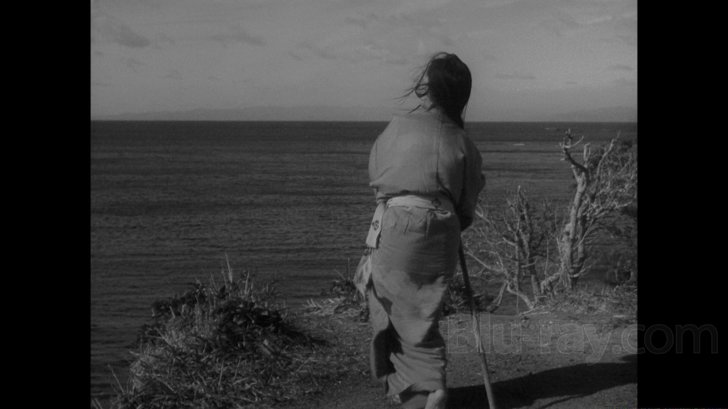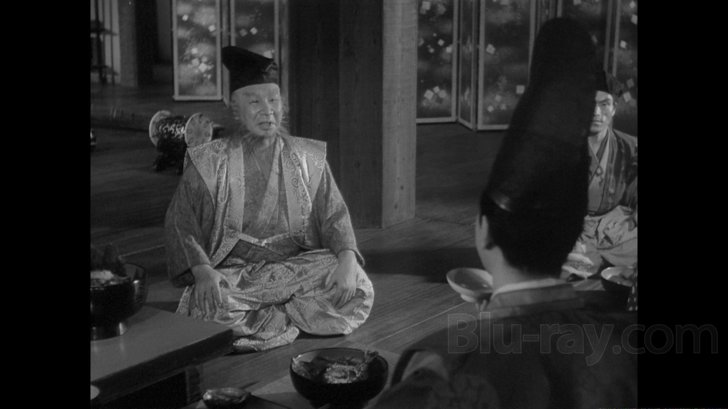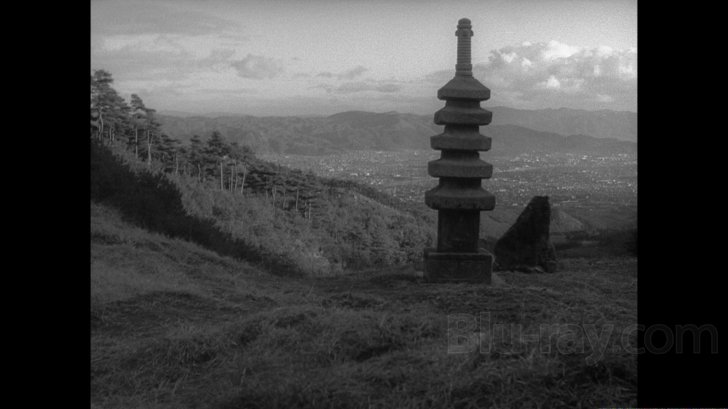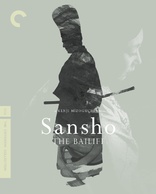Sansho the Bailiff Blu-ray Movie
HomeSansho the Bailiff Blu-ray Movie 
山椒大夫 / Sanshô dayűCriterion | 1954 | 124 min | Not rated | Feb 26, 2013
Movie rating
8.4 | / 10 |
Blu-ray rating
| Users | 0.0 | |
| Reviewer | 4.5 | |
| Overall | 4.5 |
Overview
Sansho the Bailiff (1954)
When an idealistic governor disobeys the reigning feudal lord, he is cast into exile, his wife and children left to fend for themselves and eventually wrenched apart by vicious slave traders.
Starring: Kinuyo Tanaka, Kyôko Kagawa, Yoshiaki Hanayagi, Akitake Kôno, Masao Shimizu (I)Director: Kenji Mizoguchi
| Foreign | Uncertain |
| Drama | Uncertain |
| Period | Uncertain |
Specifications
Video
Video codec: MPEG-4 AVC
Video resolution: 1080p
Aspect ratio: 1.34:1
Original aspect ratio: 1.37:1
Audio
Japanese: LPCM Mono (48kHz, 24-bit)
Subtitles
English
Discs
50GB Blu-ray Disc
Single disc (1 BD)
Playback
Region A (locked)
Review
Rating summary
| Movie | 5.0 | |
| Video | 4.5 | |
| Audio | 4.0 | |
| Extras | 4.0 | |
| Overall | 4.5 |
Sansho the Bailiff Blu-ray Movie Review
Reviewed by Dr. Svet Atanasov January 21, 2013Winner of Silver Lion Award at the Venice Film Festival, Japanese director Kenji Mizoguchi's "Sanshô Dayű" a.k.a "Sansho the Bailiff" (1954) arrives on Blu-ray courtesy of Criterion. The supplemental features on the disc include a video interview with actress Kyoko Kagawa; video interview with first assistant director Tokuzo Tanaka; video interview with Japanese film critic and historian Tadao Sato; and audio commentary with Japanese literature scholar Jeffrey Angles; The release also arrives with a booklet featuring an essay by scholar Mark Le Fanu and two versions of the story on which the film is based: Ogai Mori’s 1915 "Sansho the Steward" and an earlier oral variation in written form. In Japanese, with optional English subtitles for the main feature. Region-A "locked".

Still hoping
11th century Japan. A well respected governor (Masao Shimizu, Sanjuro) is sent into exile by his opponents. A few years later, his wife, Tamaki (Kinuyo Tanaka, The Ballad of Narayama), son, Zushio (Yoshiaki Hanayagi), daughter, Anju (Kyôko Kagawa, Madadayo) and their servant head to the island where he lives. Along the way they meet a priestess (Kikue Mori) who suggests that they use the services of two boatmen, both supposedly the best in the area. The travelers agree, but the boatmen turn out to be bandits. Tamaki and the servant are sold to the owner of a popular brothel, while Zusho and Anju are sold to Sansho (Eitarô Shindô, Drunken Angel), the brutal owner of a slave camp.
During the next ten years, Zusho and Anju are forced to work and live as slaves. Most of the time they are separated, as the men and women in Sansho's camp have different responsibilities and work in different areas. When occasionally they meet, they wonder what might have happened to Tamaki.
The living conditions in Sansho’s camp are terrible. Suffering from exhaustion, dehydration and malnutrition, the slaves routinely collapse while working and the weakest often die. The guards dispose of the bodies in the nearby forest. Taro (Akitake Kôno, The Men Who Tread on the Tiger's Tail), Sansho’s son, is so disgusted by his father’s cruelty that eventually he leaves the camp and becomes a monk.
Meanwhile, Zusho’s personality slowly changes and he becomes like the rest of the salves – living day by day and following blindly the orders of the guards. Anju continues to believe that one day she and Zusho will manage to escape the camp and reunite with their mother and father.
One day, Zusho and Anju are ordered to take a dying slave in the forest. While they collect branches, Anju manages to convince Zusho that the right time to escape has finally come. Zusho takes the slave to a nearby Buddhist temple, but Anju decides to stay because she is too weak to follow him. When word reaches Sansho that one of his slaves has escaped, he immediately orders his men to go after him.
Eventually, fortune smiles on Zusho – because of his late father’s unmatched bravery and compassion, he is appointed governor of the province where Sansho resides. He quickly declares slavery unlawful and confronts Sansho. Then, after he resigns, he begins looking for Anju and his mother.
Based on a story by Ogai Mori, Kenji Mizoguchi’s Sansho the Bailiff is a spectacular period drama that is widely considered by many film scholars and critics to be one of the greatest Japanese films ever made.
The story the film tells is simple, but there are multiple key characters that are followed closely. Additionally, past and present are closely intertwined, but a narrator points out the time changes and the important facts that are worth remembering.
The film is firmly grounded in reality and free of melodrama. Sansho’s camp, for example, is a cesspool where people are literally treated as objects. There are no graphic scenes, but the brutality is very authentic. The manner in which the guards treat the women, in particular, is quite disturbing.
As the story progresses each of the key characters faces different dilemmas. What makes the film so fascinating to behold, however, is not how they solve them, but how they perceive and judge each others' actions. Their views and the statements they produce reveal a lot about the socio-political conditions in 11th century Japan.
The film is filled with endless beautiful long shots. Especially during the second half the fluid camera movement, a Mizoguchi trademark, is very impressive.
Note: In 1954, Sansho the Bailiff won Silver Lion Award at the Venice Film Festival.
Sansho the Bailiff Blu-ray Movie, Video Quality 

Presented in an aspect ratio of 1.34:1, encoded with MPEG-4 AVC and granted a 1080p transfer, Kenji Mizoguchi's Sansho the Bailiff
arrives on Blu-ray courtesy of Criterion.
The following text appears inside the booklet provided with this Blu-ray disc:
"This high-definition digital transfer was created on a Spirit Datacine from a 35mm fine-grain master positive. Thousands of instances of dirt,
debris, scratches, splices, warps, jitter, and flicker, were manually removed using MTI's DRS and Pixel Farm's PFClean, while Image Systems'
DVNR was used for small dirt, grain, and noise reduction.
Transfer supervisors: Masakazu Itsukage/Kadokawa Pictures; Lee Kline.
Colorist: Jun Takada/Imagica, Tokyo."
Criterion's high-definition transfer is not identical to the one Eureka Entertainment used for their Blu-ray release of Sansho the Bailiff in the United
Kingdom. In addition to the insignificant framing discrepancy, brightness levels have been toned down while black levels have been
rebalanced. As a result, shadow definition and contrast are improved, and the more prominent grays from the Eureka Entertainment release
have been replaced with truer blacks (compare screencapture #2 with screencapture #6 from the Eureka Entertainment release). Generally
speaking, grain is also moderately better distributed, but in motion I had a difficult time seeing any real benefits in terms of image depth
(compare screencapture #1 with the corresponding screencapture from the UK release). The improved contrast and the rebalanced black
levels have contributed a lot more to the overall tighter image, especially with panoramic shots. There are no traces of excessive sharpening
corrections. Compression is excellent, though some extremely light noise is again noticeable. There are no large damage marks, cuts, debris,
or warps to report in this review. All in all, I prefer the overall tighter look and rebalanced black levels of the Criterion release. (Note:
This is a Region-A "locked" Blu-ray disc. Therefore, you must have a native Region-A or Region-Free PS3 or SA in order to access its content).
Sansho the Bailiff Blu-ray Movie, Audio Quality 

There is only one standard audio track on this Blu-ray disc: Japanese LPCM 1.0. For the record, Criterion have provided optional English subtitles
for the main feature.
The lossless track serves the film well. Some very light background hiss is occasionally present, but it is never distracting while viewing the film.
There is a limited range of nuanced dynamics, but this should not be surprising considering the age and production values of the film. Generally
speaking, the dialog is stable and easy follow. The English translation is very good.
Sansho the Bailiff Blu-ray Movie, Special Features and Extras 

- Performance - in this video interview, actress Kyoko Kagawa (Akira Kurosawa's High and Low, Yasujiro Ozu's Tokyo Story) recalls her collaboration with director Kenji Mizoguchi on Sansho the Bailiff and discusses her character, Anju. The interview was conducted in 2007. In Japanese, with optional English subtitles. (11 min, 1080i).
- Production - in this video interview, first assistant director Tokuzo Tanaka talks about the enormous amount of research that was done before the shooting of Sansho the Bailiff, and discusses Kenji Mizoguchi's work ethic and influence in the Japanese studio system, his relationship with composer Fumio Hayasaka, the different locations where portions of the film were shot, etc. The interview was conducted in 2007. In Japanese, with optional English subtitles. (15 min, 1080i).
- Simplicity - in this program, Japanese film critic and historian Tadao Sato discusses Sansho the Bailiff, its unique characters and themes, and the legacy of its creator, director Kenji Mizoguchi. The program was recorded in 2007. In Japanese, with optional English subtitles. (24 min, 1080i).
- Commentary - this is the same audio commentary with Japanese literature scholar Jeffrey Angles that appeared on Criterion's 2007 DVD release of Sansho the Bailiff. Mr. Angles discusses Ogai Mori's story which the film is based on, Kenji Mizoguchi's style, the unique themes and relationships in Sansho the Bailiff, etc.
- Booklet - a booklet featuring an essay by scholar Mark Le Fanu and two versions of the story on which the film is based: Ogai Mori's 1915 "Sansho the Steward" and an earlier oral variation in written form.
Sansho the Bailiff Blu-ray Movie, Overall Score and Recommendation 

Sansho the Bailiff is one world cinema's great masterpieces. It is the first film by the legendary Japanese director Kenji Mizoguchi to appear on Blu-ray in the United States via the Criterion Collection, and I hope that it won't be the last. The equally impressive Ugetsu as well as some of Mizoguchi's early films are already out on Blu-ray in other countries, so perhaps there is a good chance that these films will also eventually reach the United States. I certainly hope so. In the meantime, I urge you to consider adding Sansho the Bailiff to your collections as soon as possible. HIGHLY RECOMMENDED.
Similar titles
Similar titles you might also like

The Life of Oharu
西鶴一代女 / Saikaku ichidai onna
1952

Street of Shame
Akasen Chitai
1956

Throne of Blood
蜘蛛巣城 / Kumonosu-jô
1957

Ugetsu 4K
雨月物語 / Ugetsu monogatari
1953

Kagemusha
影武者
1980

Harakiri
切腹 / Seppuku
1962

The Painted Bird
Nabarvené ptáce / Slipcover in Original Pressing
2019

Loveless
Нелюбовь / Nelyubov
2017

Tokyo Story
東京物語 / Tôkyô monogatari
1953

Umberto D.
1952

The Insect Woman
にっぽん昆虫記 / Nippon konchűki
1963

Pieta
피에타
2012

Pather Panchali 4K
পথের পাঁচালী / Song of the Little Road
1955

La Chienne
The Bitch
1931

Europe '51
Europa '51 / The Greatest Love / English and Italian Versions
1952

A Brighter Summer Day
牯嶺街少年殺人事件
1991

Accattone
1961

Three Colors: Blue
Trois couleurs: Bleu
1993

The Club
El Club
2015

Late Spring
晩春 | 4K Restoration
1949
